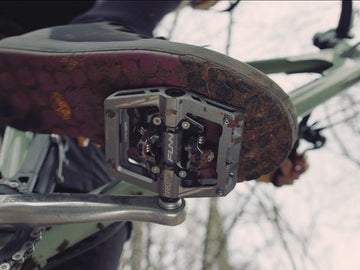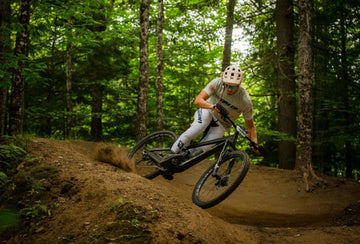Understanding the different types of bike stems is key to achieving the best balance between control, comfort, and performance. Mountain biking demands a stem that can handle varied terrain and provide the rider with the necessary confidence and control. In this comprehensive guide, we’ll walk you through the process of choosing the right stems for your mountain bike.
Choose from 3 Main Types of Bike Stems
Threadless Stems:
The most versatile and widely used, threadless stems are ideal for most mountain biking styles. They clamp onto the outside of the steerer tube and offer a wide range of lengths and angles, allowing riders to fine-tune their bike fit and handling. They are suitable for cross-country, trail, and all-mountain riding. Notable models from our selection include the Equalizer, Equalizer Zero, Crossfire, Funnduro, Tron and Stryge stems.
Direct Mount Stems:
Specifically designed for downhill and freeride mountain biking, direct mount stems like our RSX model offer a direct attachment to the fork crown. This design provides increased stiffness and stability, essential for the high stresses of aggressive downhill riding. They are shorter in length, which aids in responsive and precise steering.
Internal Cable Stems:
While less common in aggressive mountain biking, internal cable stems are an option for riders seeking a sleek, aerodynamic design and a clutter-free handlebar area. They are more frequently seen in cross-country and endurance mountain bikes where aerodynamics and a clean setup can be advantageous.

Choose Stem Dimensions
Bar Bore Dimension
It’s crucial to match the stem’s clamp diameter with your handlebars for a secure fit. The most common sizes are 31.8mm and 35mm. The 31.8mm diameter has long been standard, offering a balance of strength and flexibility, suitable for various riding styles. In contrast, the 35mm diameter, favored in more aggressive riding like downhill or enduro, provides increased stiffness and precise handling.
Steerer Tube Compatibility
The steerer tube is the part of the fork that extends through the frame’s head tube, and its diameter can vary depending on the bike and fork design. It’s essential to accurately measure the diameter of your bike’s steerer tube or consult the bike’s specifications to ensure the stem you choose is compatible. Most modern bicycles, particularly road and mountain bikes, use a 1 1/8 inch (28.6mm) diameter steerer tube, which has become a standard size. However, older models or certain specific bike types might have different sizes, such as 1 inch or oversized versions like 1 1/4 inch or 1.5 inches.
Stack Height
The stack height of a bike stem, the vertical space it occupies on the steerer tube, is crucial for bike fit. It influences handlebar height and, consequently, riding posture. A higher stack height leads to a more upright position for comfort, while a lower stack height encourages an aerodynamic stance for performance. Ensuring the stem’s stack height matches your desired handlebar level and steerer tube space is key to balancing comfort, efficiency, and handling to suit your riding preferences.
Stem Length
The length of the stem is a critical factor that varies significantly based on the specific riding style and discipline.
For cross-country (XC) riders, who often prioritize climbing efficiency and speed on less technical terrain, a longer stem is typically preferred. This longer stem length extends the rider’s reach, promoting a more forward-leaning position that can enhance pedaling power and stability during climbs.
On the other hand, downhill (DH) enthusiasts, who face steep, challenging descents and require quick, responsive handling, generally opt for shorter stems. These shorter stems provide a more upright riding position, which improves maneuverability and control in technical sections, allowing for quicker steering responses and better bike handling in tight turns.
Similarly, in enduro and trail riding, which involve both climbing and descending, choosing the right stem length is a balance. Riders typically opt for a stem that provides control on technical descents and efficiency on climbs. These stems are generally shorter than those used in cross-country but longer than those in downhill, reflecting the versatile demands of trail and enduro riding.
For an in-depth exploration of these factors and to ensure you make the perfect choice, be sure to read our comprehensive guide: ‘How To Choose and Measure Bike Stem Length?’

Rise and Drop
The rise and drop of a bike stem are crucial elements that significantly influence a rider’s position and the bike’s handling characteristics. Stem rise refers to the angle at which the stem extends from the steerer tube, affecting the height and angle of the handlebars.
Stem Rise:
A stem with a positive rise angles upwards from the steerer tube, raising the handlebars and creating a more upright riding posture. This enhances comfort, particularly on longer rides or for those with back issues, and is favored in recreational, endurance, and some mountain biking styles where comfort is key. Rises typically range from 5 to 30 degrees, with higher rises being advantageous in technical mountain biking like trail and enduro, offering improved control and visibility on rough terrain.
Stem Drop (Negative Rise):
A stem with a negative rise angles downwards, lowering the handlebars and resulting in a forward-leaning riding position for improved aerodynamics. This is ideal for road cycling and competitive disciplines like cross-country mountain biking, where speed and efficiency are key. The lower handlebar position reduces wind resistance and aids in power transfer, particularly during climbs and high-speed riding. However, this more aggressive posture might be less comfortable over longer distances.
Zero Rise:
Some stems have a zero rise, meaning they are straight without any upward or downward angle. This neutral position is a middle ground, offering a balance between an aggressive, forward-leaning posture and a more upright, comfortable stance. From our collection, the Equalizer Zero, Crossfire, and Funnduro stems exemplify the benefits of the riser design.

Choose Stem Material
Aluminum:
The most widely used material for bike stems, aluminum strikes a balance between strength, weight, and cost. Within this category, 6-series and 7-series alloys stand out for their distinct qualities and performance. This makes them a popular choice among various types of bike stems for cyclists looking for reliability.
- 6-series Alloys contain magnesium and silicon, which endow them with versatility and corrosion resistance. Funn all series stems like Equalizer, Equalizer Zero, Crossfire, Funnduro, Stryge, Tron and RSX stems are a testament to this alloy’s benefits. It represents a reliable choice, striking a balance between durability, comfort, and affordability.
- 7-series Alloys, primarily alloyed with zinc, offer greater strength and stiffness, which translates into more precise handling. Tailored for performance-seekers, 7-series products are often stiffer and lighter, though they might come at a higher cost and may be less corrosion-resistant.
Carbon Fiber:
Carbon fiber stems are favored for their lightweight and stiffness, making them a popular choice among racers and performance-oriented cyclists. They can significantly reduce the overall weight of the bike and offer excellent vibration damping properties, leading to a more comfortable ride. However, this superior performance and comfort come at a higher price point.
Steel:
Less common in modern bike stems, steel is very strong and durable, making it a good choice for heavy-duty or touring bikes where reliability is crucial. However, steel stems are heavier than their aluminum and carbon counterparts.
Titanium:
Titanium stems offer a unique combination of strength, light weight, and corrosion resistance. They are also known for their ability to absorb road vibrations, providing a comfortable ride. Titanium is often used in custom or high-end bike builds due to its cost, which is higher than aluminum but can be more affordable than carbon fiber.

Other Considerations
Versatility:
Certain bike stems, such as our Equalizer model, are engineered to be reversible, enabling riders to alternate between a rise and a drop angle. This feature enables easy adjustment of handlebar height, accommodating either an upright, comfortable posture or a lower, aerodynamic stance. Reversing the stem is an effective way to alter the bike’s geometry, suiting various riding styles or optimizing bike fit. Such stems are particularly beneficial for riders seeking versatility and convenience in their setup.
Aesthetics:
The stem’s appearance, including its color and finish, plays a key role in complementing the overall design of the bike, enhancing its visual appeal. Many riders prefer a stem that complements the overall design and color scheme of their bicycle.
Installation and Maintenance:
Consider ease of installation and maintenance. Ensure you have the right tools and follow the manufacturer’s torque specifications to avoid damage. For a detailed guide on threadless bike stem replacement, refer to our thorough guide: “A Guide to Replacing Your Threadless Bike Stem.“
Conclusion
Understanding the types of bike stems and selecting the right one involves matching it with your riding style, bike type, and comfort needs. This guide helps streamline your choice, saving time and improving your ride. The right stem makes your handlebar feel like a natural extension, enriching your cycling adventures. Gear up and enjoy a closer bond with your bike and nature!







